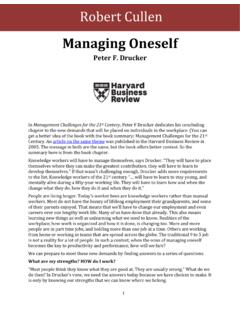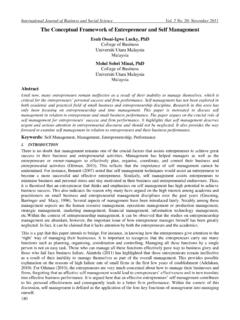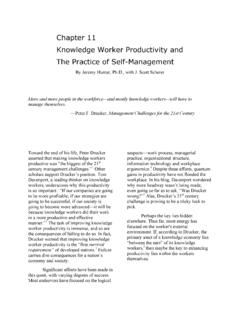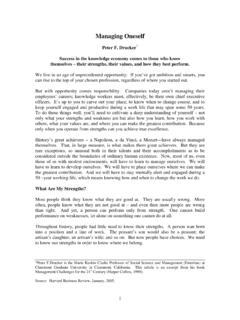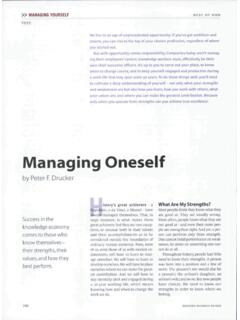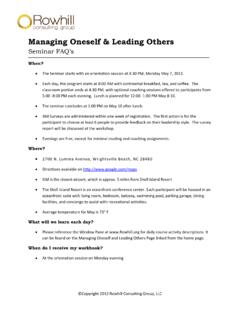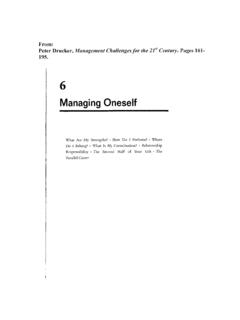Transcription of Management Challenges for the 21st Century
1 1 Management Challenges for the 21st Century Peter F. Drucker Peter F Drucker s Management Challenges for the 21st Century first came out on the threshold of the Century , in 1999. The book deals exclusively with TOMORROW s Hot Issues, says Drucker, those crucial, central, life-and-death issues that are certain to be the major Challenges of tomorrow. He sees it as a call for action. Robert Cullen 2 In the first chapter itself Management s New Paradigms we are persuaded, strongly of the need to rethink the assumptions we make and hold, as scholars, writers, teachers and practitioners of Management , often without realizing it. BASIC ASSUMPTIONS ABOUT REALITY are the PARADIGMS of a social science, such as Management , says Drucker. And those assumptions largely determine what we assume to be reality.
2 That is a problem if we hold assumptions that are no longer valid; or indeed have never been valid. These common misguided assumptions include: Management is Business Management . There is or there must be ONE right organization structure. There is or there must be ONE right way to manage people. Technologies, markets and end-uses are given. Management s scope is legally defined. Management is internally focused. The economy as defined by national boundaries is the ecology of enterprise and Management . In Drucker s view, these assumptions are close to being caricatures. They are now so far removed from actual reality that they are becoming obstacles to both the theory and practice of Management . Hence the need to think through these assumptions and try to formulate the NEW So when we talk about Management we should not be thinking of just business.
3 Management is the specific and distinguishing organ of any and all organizations . Instead of believing there is one right organization structure, we need to learn to look for, to develop, to organization that fits the task. When thinking of managing people, we have to understand that One does not manage people. The task is to lead people. And the goal is to make productive the specific strengths and knowledge of each individual. As for the assumption that technologies, markets and end-uses are we will have to increasingly work on the basis that neither technology nor end-use is a foundation for Management policy. They are limitations. The foundations have to be customer values and customer decisions on the distribution of their disposable income. So get used to the idea of setting policy and strategy on those foundations.
4 For anyone believing that the scope of Management is legal, it isn t. It needs to be operational and embrace the full process. It has to also focus on results and performance over the entire economic chain. In the 21st Century , the scope of Management isn t politically defined either. We have to get used to looking at national boundaries primarily as constraints. We may want to believe that the inside of an organization is Management s domain. But results of any institution (including business) exists only on the outside. Whether business, church, university, hospital or battered women s shelter, Management needs to start with the intended results and organize the resources to attain these results. 3 As Drucker acknowledges, the first chapter does not attempt to provide answers, but to raise questions.
5 Chapter 2 of Management Challenges for the 21st Century deals with strategy. Strategy is important because it drives business performance. In periods of rapid change, such as today, are there any assumptions and certainties on which to base our strategies? Yes, there are. Drucker names five phenomena that are certainties because trends are already in motion pointing towards their realization: The collapsing birth rate in the developed world will have tremendous social and political implications for countries. Unstable governments, redefinition of retirement and other implications are difficult to guess as the changes will be unprecedented; it is something the world has never known before. Shifts in distribution of disposable income are likely to have implications that are little understood.
6 It can shift and tip the balance on what are growth, mature and declining industries. This is important because industries whether business or nonbusiness, have to be managed differently depending on their level of maturity. Growth industries need to take a lead in innovation and be willing to take risks. Mature industries need to keep their leadership position in few crucial areas where demand can be satisfied at substantially lower costs with advanced technology and advanced quality. They need to be managed for flexibility and rapid change and shift its ways of satisfying customers from one way to another. Rapid shifts call for alliances, partnerships and joint ventures. Declining industries must manage for steady, systematic, purposeful cost reduction and for steady improvement in quality and service that allows for strengthening the company s position within industry.
7 Strategies must be based on knowledge of trends and shifts and in order to adapt accordingly. Defining performance is no longer obvious or simple. What performance means and how its defined must be thought through carefully. Strategy will be based on these new definitions of performance. Global competitiveness needs to be a strategic goal for all institutions. No institution whether business, a university or a hospital, can hope to survive, let along to succeed, unless it measures up to the standards set by the leaders in its field, anyplace in the world. The growing congruence between economic globalization and political splintering has to be addressed in strategy making. There can be no strategy without considering these fundamentals and the new realities. Meeting these Challenges successfully is the only way to succeed and prosper in times of turbulence.
8 Chapter 3: The Change Leader Drucker begins by saying that One cannot manage change. One can only be ahead of it. When painful risky change is the norm, a central challenge for Management is to make their 4 organization a change leader. A change leader sees change as opportunity, says Drucker. A change leader looks for change, knows how to find the right changes and knows how to make them effective both outside the organization and inside it. Becoming a change leader organization requires: Policies to make the present create the future. Beyond innovation, a change leader needs the willingness and ability to change what is being done today. The first change policy to consider is organized abandonment committed to abandoning yesterday. This mean putting every product, service, process, market, distribution channel, customer and end use on trial for life.
9 It calls for asking If we did not do this already, would we, knowing what we now know, go into it? When the answer is no it calls for action. Kaizen or organized improvement is another policy for change leaders. A third change policy that must be developed is exploitation of success. This calls for a focus on starving problems and feeding opportunities. A policy to create change means having a systematic policy of innovation. This means knowing how to introduce change within and outside the organization. Systematically seeking windows of opportunity calls for keeping a regular watch for unexpected successes or failures in one s own organization or those of competitors; incongruities in processes or customer behavior; process needs; changes in industry or market structures, demographics, in changes in meaning and perception; and in new knowledge.
10 (You can read more about windows of opportunity in Drucker s 1985 book, Innovation and Entrepreneurship.) Change leaders must beware of three traps: innovation opportunities that are not in tune with strategic realities; confusing novelty with innovation; and confusing motion with action. Change leaders need to think in terms of two budgets: The operational budget should be approached on the basis of the minimum needed to keep operations going. The future budget needs to be determined in terms of the maximum activity to gain optimal results. There needs to be policies that can help balance change and continuity. Drucker tells us that we need to think of change and continuity as poles rather than as opposites. Making the future. This chapter is wrapped up this way: To try to make the future is highly risky.
